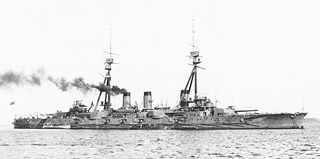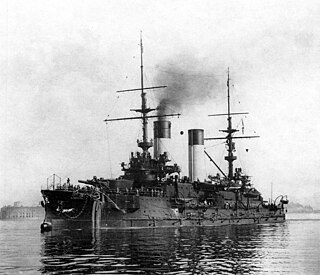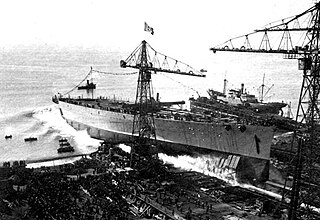
The battlecruiser was a type of capital ship of the first half of the 20th century. These were similar in displacement, armament and cost to battleships, but differed in form and balance of attributes. Battlecruisers typically had thinner armour and a somewhat lighter main gun battery than contemporary battleships, installed on a longer hull with much higher engine power in order to attain greater speeds. The first battlecruisers were designed in the United Kingdom, as a development of the armoured cruiser, at the same time as the dreadnought succeeded the pre-dreadnought battleship. The goal of the design was to outrun any ship with similar armament, and chase down any ship with lesser armament; they were intended to hunt down slower, older armoured cruisers and destroy them with heavy gunfire while avoiding combat with the more powerful but slower battleships. However, as more and more battlecruisers were built, they were increasingly used alongside the better-protected battleships.

Hyūga was the second and last Ise-class battleship built for the Imperial Japanese Navy (IJN) during the 1910s. Although completed in 1918, she played no role in World War I. Hyūga supported Japanese forces in the early 1920s during the Siberian intervention in the Russian Civil War. In 1923, she assisted survivors of the Great Kantō earthquake. The ship was partially modernised in two stages in 1927–1928 and 1931–1932, during which her forward superstructure was rebuilt in the pagoda mast style. Hyūga was reconstructed in 1934–1936, improvements being made to her armour and propulsion machinery. Afterwards, she played a minor role in the Second Sino-Japanese War.

Ise was the lead ship of her class of two dreadnought battleships built for the Imperial Japanese Navy (IJN) during the 1910s. Although completed in 1917, she played no role in World War I. Ise supported Japanese forces in the early 1920s during the Siberian Intervention in the Russian Civil War. In 1923, she assisted survivors of the Great Kantō earthquake. The ship was partially modernised in two stages in 1928–1929 and 1931–1932, during which her forward superstructure was rebuilt in the pagoda mast style. Ise was reconstructed in 1934–1937, with improvements to her armour and her propulsion machinery. Afterwards she played a minor role in the Second Sino-Japanese War.

Kirishima (霧島) was a warship of the Imperial Japanese Navy which saw service during World War I and World War II. Designed by British naval engineer George Thurston, she was the third launched of the four Kongō-class battlecruisers. Laid down in 1912 at the Mitsubishi Shipyards in Nagasaki, Kirishima was formally commissioned in 1915 on the same day as her sister ship, Haruna. Kirishima patrolled on occasion off the Chinese coast during World War I, and helped with rescue efforts following the 1923 Great Kantō earthquake.

The Yamato-class battleships were two battleships of the Imperial Japanese Navy (IJN), Yamato and Musashi, laid down leading up to World War II and completed as designed. A third hull laid down in 1940 was converted to an aircraft carrier, Shinano, during construction.

The Ise-class battleships were a pair of dreadnought battleships built for the Imperial Japanese Navy (IJN) during World War I. Both ships carried supplies for the survivors of the Great Kantō earthquake in 1923. They were modernized in 1934–1937 with improvements to their armour and machinery and a rebuilt superstructure in the pagoda mast style. Afterwards they played a minor role in the Second Sino-Japanese War.

Settsu (摂津) was the second and last of the Kawachi-class dreadnought battleships built for the Imperial Japanese Navy (IJN) in the first decade of the 20th century. Following the Japanese ship-naming conventions, Settsu was named after Settsu Province, now a part of Osaka prefecture. During World War I she bombarded German fortifications at Qingdao during the siege of Qingdao in 1914, but saw no other combat. She was placed in reserve in 1919 and was disarmed in 1922 in accordance with the terms of the Washington Naval Treaty.

Kawachi (河内) was the lead ship of her class of two Kawachi-class dreadnought battleships built for the Imperial Japanese Navy (IJN) in the 1910s. Completed in 1912, she often served as a flagship. Her only combat action during World War I was when she bombarded German fortifications in China during the Battle of Tsingtao in 1914. She sank in 1918 after an explosion in her ammunition magazine with the loss of over 600 officers and crewmen.

Nisshin (日進), also transliterated as Nissin, was a Kasuga-class armored cruiser of the Imperial Japanese Navy, built in the first decade of the 20th century by Gio. Ansaldo & C., Sestri Ponente, Italy, where the type was known as the Giuseppe Garibaldi class. The ship was originally ordered by the Royal Italian Navy in 1901 as San Rocco and sold the next year to the Argentine Navy who renamed her Mariano Moreno during the Argentine–Chilean naval arms race, but the lessening of tensions with Chile and financial pressures caused the Argentinians to sell her before delivery. At that time tensions between the Empire of Japan and the Russian Empire were rising, and the ship was offered to both sides before she was purchased by the Japanese.

Fuji (富士) was the lead ship of the Fuji class of pre-dreadnought battleships built for the Imperial Japanese Navy by the British firm of Thames Iron Works in the late 1890s. The ship participated in the Russo-Japanese War of 1904–1905, including the Battle of Port Arthur on the second day of the war with her sister Yashima. Fuji fought in the Battles of the Yellow Sea and Tsushima and was lightly damaged in the latter action. The ship was reclassified as a coastal defence ship in 1910 and served as a training ship for the rest of her career. She was hulked in 1922 and finally broken up for scrap in 1948.

The Kongō-class battlecruiser was a class of four battlecruisers built for the Imperial Japanese Navy (IJN) immediately before World War I. Designed by British naval architect George Thurston, the lead ship of the class, Kongō, was the last Japanese capital ship constructed outside Japan, by Vickers at Barrow-in-Furness. Her sister ships, Haruna, Kirishima and Hiei, were all completed in Japan.

Asahi was a pre-dreadnought battleship built for the Imperial Japanese Navy (IJN) in the late 1890s. As Japan lacked the industrial capacity to build such warships itself, the ship was designed and built in the United Kingdom. Shortly after her arrival in Japan, she became flagship of the Standing Fleet, the IJN's primary combat fleet. She participated in every major naval battle of the Russo-Japanese War of 1904–1905 and was lightly damaged during the Battle of the Yellow Sea and the Battle of Tsushima. Asahi saw no combat during World War I, although the ship participated in the Siberian Intervention in 1918.

Oryol was a Borodino-class battleship built for the Imperial Russian Navy in the first decade of the 20th century. The ship was completed after the start of the Russo-Japanese War in February 1904 and was assigned to the Second Pacific Squadron sent to the Far East six months later to break the Japanese blockade of Port Arthur. The Japanese captured the port while the squadron was in transit and their destination was changed to Vladivostok. Oryol was badly damaged during the Battle of Tsushima in May 1905 and surrendered to the Japanese, who put her into service under the name of Iwami.

Impero was the fourth Littorio-class battleship built for Italy's Regia Marina during the Second World War. She was named after the Italian word for "empire", in this case referring to the newly (1936) conquered Italian Empire in East Africa as a result of the Second Italo-Abyssinian War. She was constructed under the order of the 1938 Naval Expansion Program, along with her sister ship Roma.

The Fuji class was a two-ship class of pre-dreadnought battleships built for the Imperial Japanese Navy (IJN) in the mid-1890s. They were the first battleships in the IJN, and were constructed in the UK as Japan lacked the industrial facilities needed to build them. Their design was based on the battleships being built for the Royal Navy at that time.

The Kawachi class was a two-ship class of dreadnought battleships built for the Imperial Japanese Navy (IJN) in the first decade of the 20th century. Both ships bombarded German fortifications at Qingdao during the siege of Qingdao in 1914, but saw no other combat in World War I. Kawachi sank in 1918 after an explosion in her ammunition magazine with the loss of over 600 officers and crewmen. Settsu was disarmed in 1922 and converted into a target ship two years later to meet the terms of the Washington Naval Treaty and served until she was sunk in 1945 by American carrier aircraft. The ship was refloated after the war and scrapped in 1946–1947.












































































































































